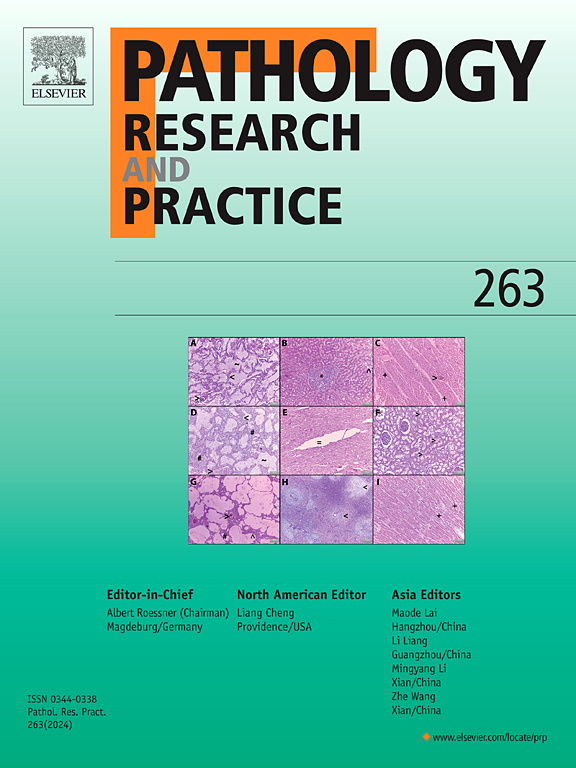肝素酶和MMP-9协同诱导门静脉微血管内皮-间质转化,促进肝癌转移。
IF 3.2
4区 医学
Q2 PATHOLOGY
引用次数: 0
摘要
背景:肝素酶(HPSE)和基质金属蛋白酶-9 (MMP-9)均可促进肝细胞癌(HCC)的转移,但它们是否共同诱导门静脉内皮细胞(pvec)内皮-间质转化(EndoMT)促进HCC转移尚不清楚。本研究旨在探讨HPSE和MMP-9联合对pvec中EndoMT及HCC肝内转移的影响,并探讨其潜在机制。方法:本研究采用基因敲低、基因过表达和抑制策略,在与人脐静脉内皮细胞(HUVECs)非接触共培养的HCC细胞中调控HPSE/MMP-9的表达或活性。采用实时定量聚合酶链反应和western blotting技术评估共培养HUVECs中内皮细胞和间充质细胞标志物的表达水平,并采用双免疫荧光分析确定其定位。在HUVECs中同时检测syndecan 1 (SDC-1)、转化生长因子-β1 (TGF-β1)、肿瘤坏死因子-α (TNF-α)和pSmad2/3的表达,前三种蛋白在上清中检测到。采用经内皮细胞迁移法检测肝癌细胞的迁移率。建立裸鼠肝癌转移模型,肝脏苏木精、伊红染色观察肝转移及门静脉肿瘤血栓(PVTT)。此外,我们对人肝癌门静脉周围组织进行了免疫组化分析,以研究HPSE/MMP-9与间充质细胞标志物表达的关系。结果:与HCCLM3细胞中单独敲除HPSE/MMP-9相比,同时敲除huvec可更有效地降低间充质标记物的表达,增加内皮标记物的表达。SDC-1、TGF-β1、TNF-α和pSmad2/3水平呈协同下调模式。双敲低策略抑制了受刺激的HUVECs释放EndoMT激活剂,从而抑制了EndoMT的进展,并在体外显著减少了HCC细胞的跨内皮迁移。HPSE/MMP-9抑制剂和TGF-β1特异性抑制剂在HCCLM3细胞中的应用,以及HepG2细胞的救援实验,也得到了类似的结果。裸鼠实验表明,双敲低HCCLM3细胞导致肝转移和PVTT率最低。免疫组织化学分析显示,随着HPSE/MMP-9表达或共表达的增加,间充质细胞标志物的表达逐渐增强。结论:HPSE/MMP-9可能在pvec中协同诱导EndoMT,最终通过SDC-1/TGF-β1 (TNF-α)/pSmad2/3通路促进HCC转移。我们的研究扩展了目前对HCC传播的复杂机制的理解。本文章由计算机程序翻译,如有差异,请以英文原文为准。
Heparanase and MMP-9 synergistically induce endothelial-mesenchymal transition in portal vein microvessels to promote hepatocellular carcinoma metastasis
Background
Both heparanase (HPSE) and matrix metalloproteinase-9 (MMP-9) can promote metastasis of hepatocellular carcinoma (HCC), but it is not clear whether they co-induce endothelial-mesenchymal transition (EndoMT) in portal vein endothelial cells (PVECs) to facilitate HCC metastasis. This study aimed to investigate the combined effect of HPSE and MMP-9 on EndoMT in PVECs and subsequent intrahepatic metastasis of HCC and to explore the underlying mechanism.
Methods
This study employed gene knockdown, gene overexpression and inhibitor strategies to manipulate HPSE/MMP-9 expression or activity within HCC cells, which were non-contact co-cultured with human umbilical vein endothelial cells (HUVECs). Quantitative real-time polymerase chain reaction and western blotting techniques were employed to assess the expression levels of endothelial and mesenchymal cell markers in the co-cultured HUVECs, while double immunofluorescent analysis was performed to determine the localization. Expression of syndecan 1 (SDC-1), transforming growth factor-β1 (TGF-β1), tumor necrosis factor-α (TNF-α) and pSmad2/3 was determined simultaneously in HUVECs, with the first three proteins detected in the supernatant. Transendothelial migration assays were executed to detect the migration rate of HCC cells. A nude mouse model of liver cancer metastasis was established, and hematoxylin and eosin staining of the liver was performed to observe the liver metastasis and portal vein tumor thrombus (PVTT). Furthermore, immunohistochemical analyses of human HCC tissues around portal vein were performed to investigate the relationship between HPSE/MMP-9 and mesenchymal cell marker expression.
Results
Compared with single knockdown of HPSE/MMP-9 in HCCLM3 cells, simultaneous knockdown was more effective in reducing the expression of mesenchymal markers and increasing the expression of endothelial markers in co-cultured HUVECs. The levels of SDC-1, TGF-β1, TNF-α and pSmad2/3 showed a coordinated downregulation pattern. The dual knockdown strategy suppressed the release of EndoMT activators from stimulated HUVECs, thereby suppressing EndoMT progression and significantly reducing HCC cell transendothelial migration in vitro. The application of HPSE/MMP-9 inhibitors and the TGF-β1-specific inhibitor in HCCLM3 cells, along with rescue experiments using HepG2 cells, yielded similar results. Nude mouse experiments showed that double knockdown HCCLM3 cells led to the lowest liver metastasis and PVTT rates. Immunohistochemical analyses displayed a gradual enhancement in the expression of mesenchymal cell markers with the increase in the expression or co-expression of HPSE/MMP-9.
Conclusion
HPSE/MMP-9 may have a synergistic effect on inducing EndoMT in PVECs, ultimately promoting HCC metastasis through the SDC-1/TGF-β1 (TNF-α)/pSmad2/3 pathway. Our research expands the current understanding of the intricate mechanisms involved in the dissemination of HCC.
求助全文
通过发布文献求助,成功后即可免费获取论文全文。
去求助
来源期刊
CiteScore
5.00
自引率
3.60%
发文量
405
审稿时长
24 days
期刊介绍:
Pathology, Research and Practice provides accessible coverage of the most recent developments across the entire field of pathology: Reviews focus on recent progress in pathology, while Comments look at interesting current problems and at hypotheses for future developments in pathology. Original Papers present novel findings on all aspects of general, anatomic and molecular pathology. Rapid Communications inform readers on preliminary findings that may be relevant for further studies and need to be communicated quickly. Teaching Cases look at new aspects or special diagnostic problems of diseases and at case reports relevant for the pathologist''s practice.

 求助内容:
求助内容: 应助结果提醒方式:
应助结果提醒方式:


